Can This Smartwatch Save Fitbit?
The wrist is a tough piece of territory. Aside from “because it’s cool,” smartwatches haven’t presented a compelling use case to most people, who are pretty happy with what their phones offer (including, of course, a clock). Sales have been tepid in the category even three years after the Apple Watch emerged. Until recently, the situation has been much better for smartwatches’ cheaper cousins, fitness trackers, which sell over twice as many products globally–happy news to fitness tracker granddaddy Fitbit, until recently.
This year is more of a slog, with sales of fitness trackers expected to shrink for the first time. Global fitness tracker sales were on a steady rise until last year, to 49.2 million devices sold, says IDC, but this year, it expects that number to fall to 47.6 million. That’s still a lot more than the 30.7 million expected for smartwatches, but that newer category is growing fast, up from 20.5 million last year.
Fitbit is feeling the burn: It posted a $146.3 million loss for 2016 and earlier this month reported that, despite healthy growth in Asia, its second-quarter revenues in the U.S. had shrunk by 55% to $199 million. Sales of Fitbits are way down, too. Last year, it sold 5.7 million activity trackers during the second quarter. This year that figure dwindled to 3.4 million. (Fitbit says it’s sold 67 million fitness trackers since the company’s inception; the Charge 2 is its most popular wearable right now.)
The company positions its long-promised smartwatch, the Ionic, as the next step in fitness and health tracking, calling it a “a health and fitness first platform.” But in a world of dwindling fitness band sales and growing numbers of Apple Watches (which for a time outpaced Fitbits in sales), the new watch tells of an existential moment for the company. Facing competition from Apple, Samsung, and a mess of models based on Google’s Android Wear OS, Fitbit needs to expand market share. To survive, it has to find a way to put more digital bands–whether they are called fitness trackers or smartwatches–on the wrists of the masses.
The Ionic has roughly the same dimensions and weight of the entry-level (38 mm size) Apple Watch Series 2. Starting at $300 when it goes in sale in October, the Ionic will be $69 cheaper than its Apple rival. And it’ll boast, naturally, a fitness tracker’s DNA. Its 1.42-inch LCD touchscreen can go extremely bright (the same 1,000 Nits as Apple’s) to compete against sunlight. But in my brief time with the Ionic at Fitbit’s San Francisco headquarters, its LCD didn’t seem to match the color richness of Apple’s OLED screen. (Its 348 x 250 resolution is roughly comparable, however.) Comparisons to the Apple Watch could all change next month, however, when the company is expected to introduce its third-generation model.
Fitbit’s LCD shows not only stats but also animated demonstrations of exercises for user-customized workouts in the new Fitbit Coach app. Ionic is waterproof (down to 50 meters, like the Apple Watch 2) for swimmers and has built-in receivers for the GPS and GLONASS satellite location services (like Apple), eliminating the need for a smartphone when self-mapping. A new feature called Run Detect senses movement and turns on location tracking only when needed. With GPS/GLONASS on or music playing, the battery runs down in 10 hours; otherwise, Ionic achieves over four days of battery life, says Fitbit. That’s more than twice what Apple promises.
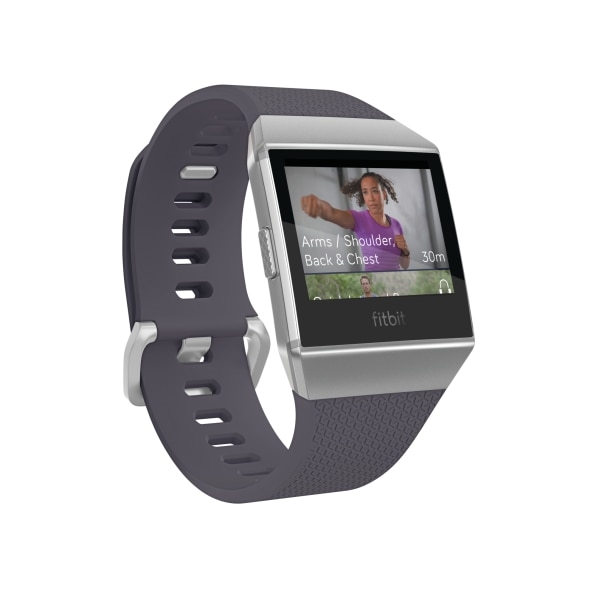
For the Ionic to succeed, it has to be a top-notch fitness tracker that stands well above competitors to earn its premium price. “Over the past couple of years, the market has been overrun by a number of me-too copycats,” says Ramon Llamas, research manager for wearables at IDC. “Once they do everything about the same, you run the risk of it becoming just a commodity.” Both Nike and Jawbone got out of the fitness tracking business for that reason, says Llamas.
To keep growing, fitness trackers have to keep providing new insights, according to Llamas. “Because once you’ve nailed getting your steps enough times, what is the next incentive?” he says.
Fitbit says that the Ionic evolved from its fitness bands. James Park, the company’s cofounder and CEO, says it was the result of having too many cool sensors and other features to squeeze into a standard fitness band. “The only way we could do that was in a larger form-factor device than a traditional tracker.”
But this is smartwatch territory, and Fitbit has equipped the Ionic with a music player, an NFC chip for wireless payments, and an operating system called Fitbit OS supporting third-party apps. (Fitbit refuses to say if its OS is based on Linux or some other technology, but apps will be Java based.) Fitbit purchased two companies in 2016–foundering smartwatch pioneer Pebble (for $23 million) and mobile payments startup Coin (for an undisclosed amount)–to make it happen. Like many fitness trackers and all smart watches, Ionic also displays alerts from Bluetooth-connected smartphones (running Android or iOS), such as caller ID and calendar reminders.
One clear sign that the Ionic is not gunning for Apple: It doesn’t have a cellular connection for making calls or accessing the net, which is all but certain to be an option in the next Apple Watch. (Some lower-priced phones, such as the $192 ZTE Quartz also have cellular modems.)
Related: Will the new Apple Watch finally make smartwatches a mainstream thing?
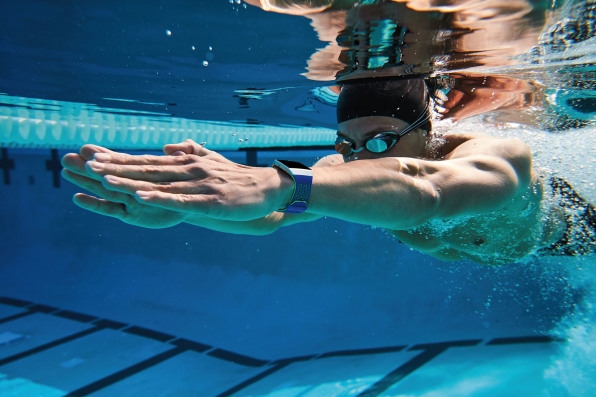
Payments, Apps, And Looks
The Ionic might be a tough sell if it were simply an enormous fitness tracker, but it offers quite a bit more. A built-in music player with 2.5 GB of storage holds about 300 songs–eliminating the need to bring a smartphone along on a run. It can store both files loaded from a computer over Wi-Fi or downloaded through a phone with a Pandora Plus or Premium account (starting at $5 per month). Fitbit is launching a wireless headset, the $130 Fitbit Flyer; but the Ionic works with any Bluetooth headset or earbuds, such as Apple’s $159 AirPods. (A voice-guided version of the Fitbit Coach app is coming in 2018.)
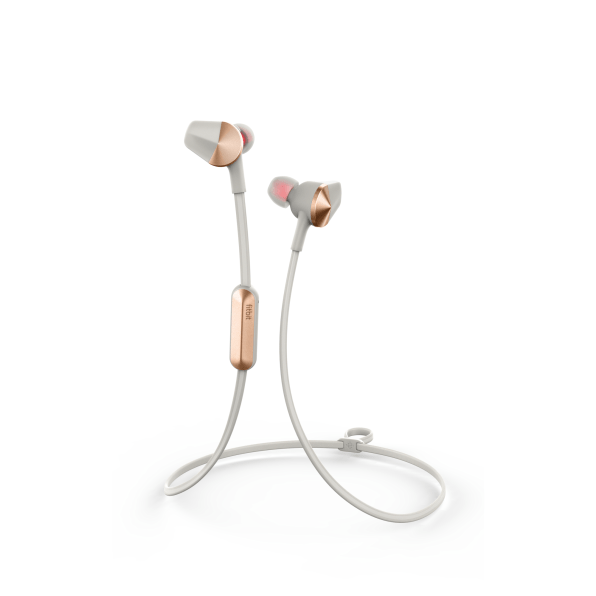
Fitbit believes that wireless payments will be another killer feature: It snapped up Coin to make that happen. “I wouldn’t mind being able to grab a cup of coffee or a smoothie after I have a workout,” says Llamas. “And . . . I don’t usually carry my wallet when I go running.”
In acquiring most of Coin, Fitbit got a payments service, now dubbed Fitbit Pay, that will let the Ionic take the place of an Amex, MasterCard, or Visa credit card. Fitbit is also bringing on banks–announcing deals with Bank of America, Capital One, HSBC, and US Bank, among others–so the Ionic can also stand in for debit cards. Including the payments chip is mostly staking territory for future applications. “Here in the United States, the adoption of mobile payments is still rather low, almost appallingly so,” says Llamas.
Aside from its built-in software for fitness tracking, music, and other core features, Ionic launches with four apps from other providers—Accuweather, Pandora, Starbucks (for displaying a QR code to make purchases), and the Strava social-sharing fitness tracker service. A few apps in the works for later this fall include Adidas All Day, Flipboard, Nest, and Surfline. All the initial apps will be free, and it’s not clear if any future ones will be paid, although many will likely be tied to subscription services, as Pandora is.
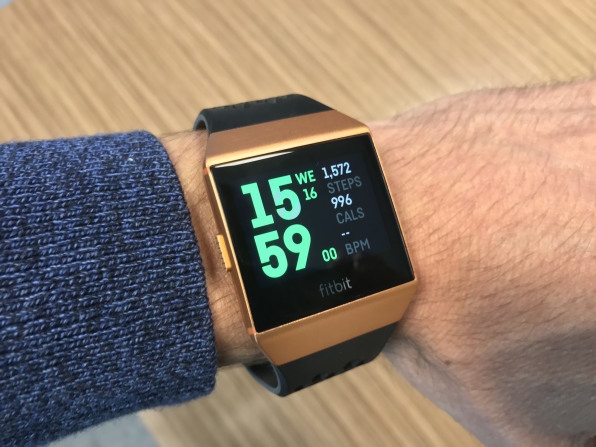
None of the apps for Pebble’s devices will be able to run on Ionic, but Fitbit hopes that Pebble developers will embrace its device. “A lot of the Pebble DNA is in Ionic,” says Park. From Pebble, Fitbit inherited a software development kit that lets programmers write Java-based apps in an online coding tool. “You can just fire up a browser and go to a URL to fire up a developer environment,” says Park.
Coming up with compelling apps is a challenge for all smartwatches, says Llamas. “Not a lot of them solve the question of, ‘How is this going to help me?’” he says. Ionic being foremost a fitness tracker may lower the pressure on Fitbit to dazzle buyers with a vast app collection, although attracting Pebble developers could help with that. “When I look back on Pebble, there was a lot to like about it,” says Llamas. “A lot of the apps weren’t half bad.”
Another continuing challenge for smartwatches, according to Llamas, is aesthetics. “People want a watch that looks like a watch,” he says, calling traditional watchmakers such as Fossil more design-savvy than tech companies like Apple and Samsung. That includes a round shape and virtual watch faces that resemble the analog kind. Skeuomorphism–digital imitation of the analog world–is still popular with watch buyers, he says.
James Park disagrees. “For us the decision was driven by function more than form,” he says. “If you think about the digital age and the display of information . . . actually a rectangular form factor is better for that.”
In 2015, Fitbit hired HTC’s VP of industrial design Jonah Becker to take the same role at Fitbit and build an in-house team; the Ionic is Fitbit’s first fully homegrown creation. Becker is known for leading the design of HTC smartphones and the Vive virtual reality headset, which, like most boxy VR gear, put function far above form.
The Ionic is well constructed, with a good fit and finish. Its aluminum unibody doubles as an antenna for GPS and Bluetooth. Unlike my Fitbit Charge 2, with a heart-rate sensor that pokes into my wrist, the wide, flat underside of the Ionic sat comfortably against my skin. But while slick looking, the metal box does not represent a breakthrough in design.
Fitbit tradition continues in the plethora of configurations. There are three finishes for the main unit–orange, silver, and graphite. The $300 entry-level price (technically $299.95) offers rubbery bands in various shades of gray. Sport bands, including orange and lime-green options, are a $30 upgrade. Two leather bands–brown and “midnight blue”–go for $60 each.
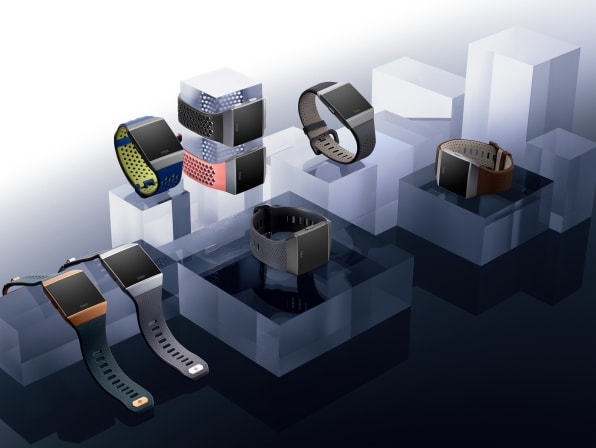
The Health Tracker
Fitbit has long been pushing beyond reporting basic metrics like number of steps taken and heart rate, trying to ferret out bigger health insights from the data it collects. The company says that 95% of all National Institutes of Health-funded studies that include wearable devices use Fitbits.) Here is where Fitbit’s decade of user data helps it develop and test features that provide deeper insights than new device makers can.
Take the Relax Guided Breathing exercise feature, introduced with the Charge 2 tracker in fall 2016. Anyone who’s tried meditation knows that slow, deliberate breathing helps reduce stress. Fitbits don’t have sensors to directly measure breathing rate, but it found a way to utilize the heart rate sensor.
“It’s a well-known phenomenon that, if you breathe deeply, you can see a variation in the inter-beat interval, the time between heartbeats,” says Subramaniam Venkatraman, director of research algorithms. The routine begins by measuring your normal heart rate to calibrate the exercise to your fitness level. “The right rate for phased breathing for someone who is an athlete or does yoga, is not the right rate for someone who is not as active,” he says.
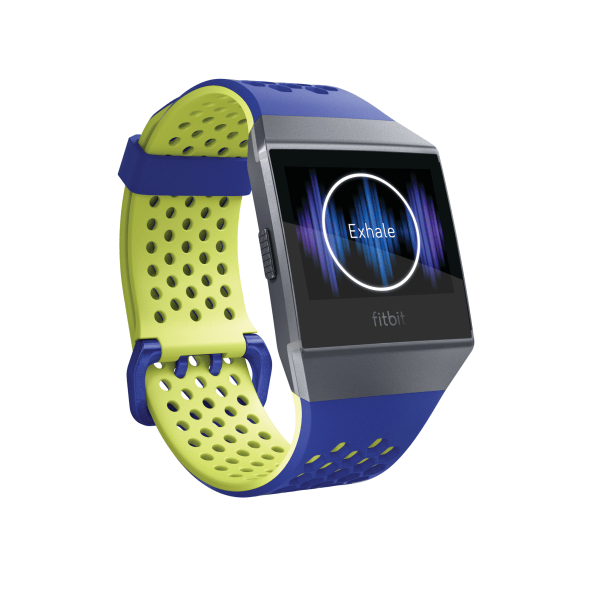
In March, Fitbit introduced a new band, the $150 Alta HR, that uses the heart-rate sensor for another purpose: to track sleep. (Software upgrades brought the capability to some other models, such as the Charge 2.) The new Sleep Stages feature measures the variability in heart rate to determine the breakdown of sleep stages–such as light, deep, and REM–that wearers get each night.
Ambitions are especially big in terms of medical insights: The watch is equipped with sensors for future applications that Fitbit hasn’t even fully figured out yet. “What we realized a few years ago, as [we] started getting more integrated into the healthcare ecosystem, trying to address more serious and chronic medical issues, is that it’s going to require the development and deployment of more advanced sensors and richer displays,” says Park.
Alongside a sensor that measures heart rate, the Ionic has Fitbit’s first relative SpO2 sensor, consisting of two lights and receivers that analyze the color of blood to determine its oxygen content. Despite this engineering investment, the SpO2 sensor will be useless when the Ionic debuts in October. Fitbit’s data science team has theorized several things it can do with the data in later software upgrades, such as diagnosing sleep apnea, in which people briefly stop breathing during sleep. “It’s one of the most common causes of sleep disruption,” says director of research algorithms Conor Heneghan, who lead the development of the sleep stages feature. When people miss a breath, the blood oxygen level drops, as does the heart rate. Heneghan thinks Fitbit can use the Ionic’s sensors to pick up the changes and clue in users that they may have apnea.
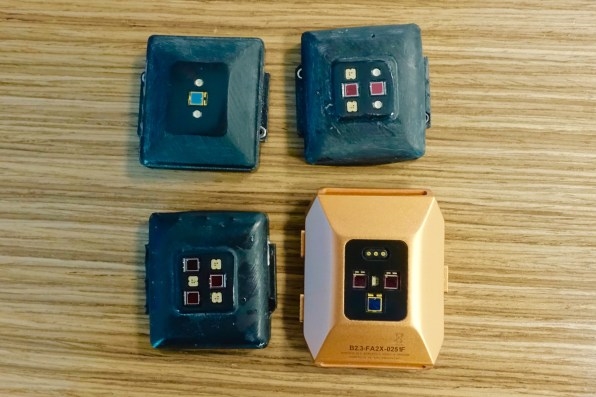
Another future Fitbit feature could be looking for signs of atrial fibrillation, or AFib–an irregular heartbeat caused by a quivering of the atria, the two upper chambers of the heart. Venkatraman thinks that Fitbit will be able to use its heart-rate monitor to find signs of AFib and alert users that they should get their heart checked. It’s currently taking part in a study with Georgetown University to see if the PurePulse technology and algorithms that Fitbit uses on several of its trackers are up to the task.
“I’m all for more sophisticated [fitness] tracking,” says IDC’s Llamas. “If some platform is able to track my progress over a number of years and put together a profile of me and then be able to say later on, okay, based on what we know about you, Ramon . . . we can make better predictions about how you are going to do in the future.”
To work at this level, Fitbit needs not only a lot of data for each user, but a lot of data for a lot of users. The pool of (anonymized) user data is what has allowed Fitbit to create new services.
“We got data from a lot of users, and what we saw was these abnormalities in the heart rhythm,” says Venkatraman, about the origins of the AFib detection work. “In parallel, we started to get reports from people in the wild [saying], ‘Hey, we saw that our heart rate had gone really high, so we went to our doctor, and our doctor ran a test and found that we had atrial fibrillation or some other cardiac issue.’”
By providing that info to Fitbit, customers are clueing it into relationships between data patterns and medical conditions–in this case, heart rate and AFib. Other customers have been recording the specific exercises they do. Fitbit already has a capability called SmartTrack that uses the device’s motion sensors to recognize activity types like running or swimming.
But users are providing data that may further refine the feature. “A fraction of our users would sometimes label their data,” in their fitness app, says Venkatraman. “They would say, ‘I went and played soccer, or I went and danced, or I went and lifted weights.’” Users were labeling training data–an essential element for machine learning AI. By collecting enough sensor data labeled for a corresponding activity, such as dancing, Fitbit may be able develop an algorithm to recognize when users are dancing and provide more fine-grained fitness insights.
The company reported 23.2 million active users at the end of 2016, providing oceans of anonymized data collections, such as over 5 billion nights of sleep, 82 million hours of heart rate, and 160 billion hours of exercise. And for years, the company has sold devices to companies in a bid to improve employees’ health: The devices are used in about 1,300 corporate health programs. Customers with United Healthcare can even earn $1,500 in rewards for meeting fitness goals. (Fitbit says it has refined its data analysis tech to foil old cheat techniques like strapping fitness bands to dogs.)
In a world increasingly rich in AI-based services, those with the most data to train the services win. As Amazon’s legions of customers make its Alexa assistant smarter by chatting with it, Fitbit’s multitudes of sporty users increase its fitness prowess just by moving. With its tried-and-true set of motion, heart-rate, and now blood oxygen level sensors, Fitbit’s Ionic watch could further fortify its data expertise and its lead in fitness. That distinguishes Fitbit from its me-too rivals–at least for now.
Fast Company , Read Full Story
(49)








